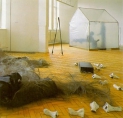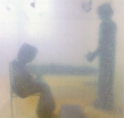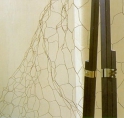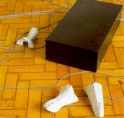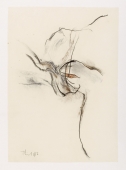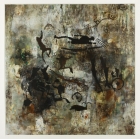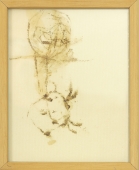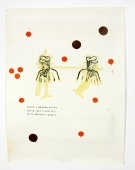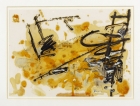
Artist | Renate Koch (*1963)
https://www.artist-info.com/artist/Renate-Koch
Biography
Biography
1963 in Erlangen geboren
1983 Studium der freien Bildhauerei an der Staatlichen Akademie der Bildenden Künste Karlsruhe bei Otto Herbert Hajek
1990 Meisterschülerin von Prof.O.H.Hajek
lebt und arbeitet in Karlsruhe
Solo Exhibitions
Solo Exhibitions
1992 JETZT, in der Zentralen Kunsthalle in Moskau (GUS)
1992 HIER IST, in der BBK-Werkstatt , Haus an der Mehlwaage, Freiburg
1993 Von hier - de Là, R. de Montreuil, Montreuil-sous-Bois (F)
1993 BIS, in der Galerie der alten Hauptfeuerwache in Mannheim
1993 Galerie Patricia Dorfmann (F)
1994 ART HOTEL, Galerie Patricia Dorfmann, Amsterdam (NL)
1994 Stipendiatenausstellung im Haus der Kunststiftung Baden- Württemberg, Stuttgart
1994 Galerie FORAUM Bereiteranger, München
1995 Galerie L'Engage, Rennes (F)
Group Exhibitions
Group Exhibitions
1985 Bildhauerklasse Prof.O.H.Hajek, im Lichthof der Staalichen Akademie der Bildenden Künste Karlsruhe
1986 Kolloquium Werden die Akademien aus unserer Zeit verdrängt? im Kunstverein Karlsruhe
1987 9. Mainzer Minipressen Messe, am Rheinufer in Mainz
1987 Plastik 1987 Leonberg, im Stadtpark und Rathaus Leonberg
1988 Salzgitter Symposien 1988, im Stadtpark Salzgitter-Lebenstedt
1989 Einblick - Bildhauer der Akademie Karlsruhe, Klasse Prof.O.H.Hajek und Gäste, im Hauptbahnhof Stuttgart
1990 Japanische Metallbildnerausstellung, Galerie Ginza Wakko, Tokyo, Japan
1990 Bildhauersymoposium Weingarten, Weingarten/Ravensburg
1991 Atelierausstellung im Tempel, Karlsruhe
1991 Stationen, Ausstellungssymposium im Rahmen der Schloßfestspiele Ellwangen, Schloß Ellwangen,
1991 Cernin Palais, Außenministerium der CSFR, Prag, Musuem Altes Rathaus in Bratislava
1991 Diagonale, Galerie der Stadt Bratislava, Schloß Mirbach, CSFR
1992 Projekt Istropolitana, Galerie Gerulata, Bratislava, Slovakische Republik
1992 Künstler aus Bratislava, Gent, Karlsruhe, Posen, Prag, Wien, Zagreb
1992 Kontakte - Kontakty 92, Ausstellung deutscher, tschechischer und slovakischer Künstler im Museum Ostdeutsche Galerie in Regensburg
1992 Plastiken im Schloßhof, Museum Schloß Ettlingen
1992 Notizen, Galerie Vysherad, Prag, Tschechische Republik
1993 Atelierausstellung im Tempel, Karlsruhe
1993 14. Wanderausstellung der Kunststiftung Baden-Württemberg, begonnen im Kunstverein Mannheim
1993 Sammlung Westermann, Galerie der Stadt Sindelfingen
1993 FIAC, Galerie Patricia Dorfmann, Paris
1994 Atelierausstellung im Tempel, Karlsruhe
1994 Créations de l'Art Contemporain, Astrolabe in La Rochelle (F)
1994 FIAC, Galerie Patricia Dorfmann, Paris
1996 Galerie Poller, Frankfurt/M.
1996 Skulptur im Südwesten, Badischer Kunstverein, Karlsruhe
1999 Frauenperspektiven '99, Prinz-Max-Palais, Karlsruhe
Scholarships
Scholarships
1990 Stipendium Farbwege Moskau
1992 Stipendium der Kunststiftung Baden-Württemberg
About the work (deutsch / english)
About the work (deutsch / english)
„LAMES“
Ein Zeichen kann der Verweis auf einen Vorgang aus der Vergangenheit sein oder eine Geschichte, die stattgefunden hat. Solch ein Bild aus der Vergangenheit hat klare Konturen in der Erinnerung und lebt für sich selbst. Es beeinflußt ein neu entstehendes in der Gegenwart und wird auch jedes zukünftige beeinflussen.
Eine Skulptur oder ein Bild bestehen auf der einen Seite aus ihren Einzelteilen oder einzelnen Formen, aus denen sie zusammengesetzt sind und die ihr eigenes Leben haben; auf der anderen Seite kommt die Bewegung des Betrachters hinzu, die das Bild in sich verdichtet. So wird jeder Bildgegenstand, der für sich steht, durch die Bewegung eines Gegenübers vervielfältigt. Daraus ergibt sich ihre eigene Lebendigkeit, eine Fragestellung an den Umraum, an den Gegenstand und an ihre Wechselwirkung untereinander.
Der Schritt von der Bild(er)findung zum Bild ist verbunden mit der Art einer Bewegung, der Beobachtung, der Zeit, der Sprache, aus einem erlebten Moment heraus. Von innen und von außen, von gesagt und ungesagt, von gezeigt und ungezeigt, von versteckt und öffentlich, von bewußt und unbewußt.
Die Trennung zwischen Realität und Phantasie läßt sich nicht festlegen, sie ist mit dem Bild eines Labyrinths vergleichbar, das eine subjektive Mitte umgibt. Das Außen und das Innen, das Vertraute und das Fremde, das Gesehene und das Ungesehene, das Schnelle und das Langsame, das Gesagte und das Ungesagte, das Bewußte und das Unbewußte, das Reale und die Illusion.
„Wie wäre diese Erklärung: ,Ich kann etwas als das sehen, wovon es ein Bild sein kann? Das heißt doch: Die Aspekte im Aspektwechsel sind die, die die Figur unter Umständen ständig in einem Bild haben könnte.’" (Wittgenstein, Philosophische Untersuchungen)
Text von Renate Koch
Inside / Outside: Surrounded by four women
The exhibition "Out of Place" (August - September 1998, Chapter, Cardiff) came together through the desire of these four artists - Nilofar Akmut, Reiko Aoyagi, Phyllida Barlow, Renate Koch - to continue a relationship that began with a workshop in Pakistan. Although there were a dozen participating artists in that workshop, these four artists found a common desire to continue this long-distance relationship. Their individual practices rely on a dedication to pursue a material solution to the questions facing them. It is imperative that the exhibition is not viewed as a collaborative whole but the sum of individual efforts made by each artist. In particular, they have all responded to the space provided by the gallery. I had the privilege of viewing the works whilst they were being installed and to talk to each of the artists.
The title of this essay is a reference made at the time of my introduction to the group and sets the tone of the exhibition that is both gendered and not about gender as such. The show is very serious in its intent and also quite ironic and playful. Naturally I bring to the works a male gaze, a phallo-centric sensibility, one that the works could be read as strenuously challenging.
I began with the work of Nilofar Akmut because she was the organiser of the Pakistan workshop in which lie buried the concerns of the show. Then I followed a logical progression through the spaces starting with Reiko Aoyagi, Renate Koch and finally Phyllida Barlow. There are many common themes and stark contrasts. This was a journey into space and to some extent into time. Process, being the key to the groups formulation, was all around me. The mood seemed at odds with the 90s and somewhat sombre. These artists are not selling objects to the art market, they are continuing in the great tradition of art making which is the pursuit of human truths, albeit in highly individualised practices. This in itself makes for interesting viewing.
From the dark enclosed space of Akmut's work The Suppression of Meaning, Pol / poe / tics of Mem / ory, we move into the light of Aoyagi's Passing. These two artists seem to have arrived at opposite treatments of a similar conundrum. How to make visible an emotional state, a lost history a melancholia? The naming of the artists' cultural backgrounds, Akmut (Pakistan) and Aoyagi (Japan), seems again to be contradictory: essential but not central to the concerns of the project. Akmut's space plunges us into a heart of darkness where violence is everywhere, her own past works have been obliterated and remade to represent the destruction of the values of the Indian subcontinent. Some of her past works derive from projects with Jo Spence concerning making family histories visible, highlighting the invisibility of women's history, Akmut has used the metaphor of destroyed tea-chests and the vitrine as a place of birth, rest and death to strike a balance between destruction and creation. The packaging and transportation themes echo Akmut's situation, her work inhabits a space in which she can acknowledge two places in her search to situate herself, not an uncommon phenomenon amongst migrant communities in the West.
Reiko Aoyagi appears to respond to an equivalent but very different sense of displacement by revealing the layers of history hidden within the fabric of the building and then bathing it in natural light. Where the former has enclosed the latter has revealed. The consequences are the same for both: a terrifying feeling of vulnerability, a tearing asunder of the past and the present, and the presentation of a very uncertain future. Aoyagi's self-imposed exile has led her to shed fixed notions of cultural traditions. She works here as an artist from another place but is not bound up with stereotypical values often associated by a Western audience with Japan, values of either tradition or kitch. Her formal concerns lie with space and light and this dramatic environmental quality of her work engenders an emotional response in the viewer, this is both her artistic strategy and the work itself. The space induces a quality of vulnerability, pain and empathy."What have I done?"she asked of herself. A universal question posed by all of us as we ponder our contributions to the human condition. Aoyagi bares the scarred walls of the gallery revealing a question of guilt. Artists, of course, have a very active role in this questioning as they fabricate materials and actions in real spaces inducing a plausible response.
Renate Koch's kinetic sculptures are composed of a set of four pieces. Each one is inherently different but all contain a common humanistic approach. Her material concerns extend to the display of the containers for the works, including a greenhouse type of structure, entitled 'As Far As' covered in a translucent skin-like material. It is first encountered with human scale figures that respond in motion to the touch of a button. Her pieces emanate sound, the sound of mechanical movements or the sound of Monteverdi's aria, "Lamento di Arianne" in the work Lame. These Lamentations echo in sound the melancholia of the exhibition as a whole. Koch's work depicts movement and its restraint, movement that is caged or trapped. The movement in Lame is limited by umbilical attachments to a black box, her work is suggesting that we are free to move but only within a severely restricted arena. The poetics created by the sound and movement contradict our expectations of mechanical repetition. Pulsating objects enclosed in plastic skins reference the human body. This reveals Koch's humanistic concerns and our attempts to communicate within restricted cultural and/or subject positions.
One of the common features of this group of artists is that they have all experienced a Western-style art-training steeped in Euro-centric art history. Non-European art is seen as a pale imitation of the West's own art production. These artists attempt to work within the accepted limitations of this position whilst simultaneously exploring questions central to their specific practices informed by their different cultural positions.
In the complex matrix that is the history of the 20th Century Pakistan emerged as a secular state and homeland for muslims after a bloody event infamously known as "Partition". Immediately histories were re-written by all sides. How do outsiders respond to a place like this? How can a multi-racial grouping hope to survive the deepseated anxieties of the present generation? Japan and Germany set into train some of the bloodiest attempted conquests of their respective regions in the Northern Hemisphere in this century. England colonised most of the world and hardly in the benign manner popular culture would have us believe. The geography of the gestating workshop and Pakistans history of martial regimes and its current nuclear testing does beg the question whether the practice of artists can contribute to a constructive dialogue. Akmut points a finger at our collective post-colonial subconscious in the ritual destruction of writing and family history, both historical tools of struggle against repression. The other artists echo the loss and melancholy of pointless destruction in this century which continues into the present.
Unlike Koch, Phyllida Barlow is London based and therefore has the advantage of going to a place that is somewhat more familiar to her. Time and Time Again is an extraordinary work. It was created for the space, assembled on site and echoes the windows by the punctuation of the forms, referencing the hole in the tradition of sculpture in the West. Barlow's work is characterised by being large and bulky, interrogating notions of ugliness. By occupying most of the floor space, and by its sheer size the work actively pushes the viewer into a corner. This is not an easy work to look at, there is no obvious vantage point.
The work is constructed around two main characters that emerge from childhood games and suggest an adult foreboding. Container-like structures stripped of their contents surround the figures. A loss of memory a lack of detail and the punctured surfaces seem to suggest the impossibility of ever filling them again. The pieces have been worked on in a violent fashion. A pinkish hue dominates, not the red of blood but a gentler colour suggesting not momento mori but a painful living flesh exposed. The pieces sit on plinths with wheels suggesting a transience that conflicts with their structural identity. Instead of being rock-solid the almost architectural forms suggest an enormous vulnerability.
The whole exhibition asks where is sculpture going now. It is seeking a way of working that is artist led and not market driven. The identifiers of art being returned to the discourse of the makers rather than the cataloguing of ownership. During the time I spent with the artists and their work many shared concerns and stark contrasts became apparent. But overall I experienced this exhibition as an interrogation of the history of violence, by four women whose work suggests that the perpetrators are within us all. This violence seems endemic to all the specific places that serve as cultural background to the artists. However, women have traditionally been seen as healers and this is also reciprocated and explored by these artists. The fragile division between violence and healing is felt throughout the exhibition. By choosing to remain out of place the artists are then able to continue their exploration of the inside/outside relationship that haunts everyone.
Text by Sunil Gupta, London 1998
(Sunil Gupta is an Indian born, Canadian citizen who lives and works in London. His next curatorial project with OVA is The New Republics: Contemporary Art from Australia, Canada and South Africa)
Internet
Internet
 offers / Requests offers / Requests  |
About this service |
|---|
 Exhibition Announcements Exhibition Announcements  |
About this service |
|---|
 Visualization |
Learn more about this service | ||
|---|---|---|---|

Interested in discovering more of this artist's networks?
3 easy steps: Register, buy a package for a visualization, select the artist.
See examples how visualization looks like for an artist, a curator, or an exhibition place: Gallery, museum, non-profit place, or collector.

Exhibition History

|
SUMMARY based on artist-info records. More details and Visualizing Art Networks on demand. Venue types: Gallery / Museum / Non-Profit / Collector |
||||||||||||
| Exhibitions in artist-info | 7 (S 1/ G 6) |
Did show together with - Top 5 of 26 artists (no. of shows) - all shows - Top 100
|
||||||||||
| Exhibitions by type | 7: 4 / 0 / 3 / 0 | |||||||||||
| Venues by type | 6: 3 / 0 / 3 / 0 | |||||||||||
| Curators | 0 | |||||||||||
| artist-info records | Feb 1996 - May 2004 | |||||||||||
|
Countries - Top 3 of 3 Germany (3) Italy (2) United Kingdom (1) |
Cities - Top 5 of 5 Genova (2) Karlsruhe (2) Cardiff (1) Dresden (1) Frankfurt am Main (1) |
Venues (no. of shows )
Top 5 of 6
|
||||||||||
|
Curators (no. of shows)
Top 0 of 0 |
| GEDOK Künstlerinnenforum Karlsruhe | G | Apr 2004 - May 2004 | Karlsruhe | (25) | +0 | |
| Kunsthaus Raskolnikow e.V. - Galerie | S | Sep 2000 - Sep 2000 | Dresden | (20) | +0 | |
| Rebecca Container Gallery | G | Jul 2000 - Aug 2000 | Genova | (11) | +0 | |
| Rebecca Container Gallery | G | Mar 1999 - Apr 1999 | Genova | (11) | +0 | |
| Chapter | G | Aug 1998 - Sep 1998 | Cardiff | (4) | +0 | |
| Badischer Kunstverein | G | Oct 1996 - Dec 1996 | Karlsruhe | (174) | +0 | |
| Galerie Poller (Frankfurt a.M.) | G | Feb 1996 - May 1996 | Frankfurt am Main | (82) | +0 | |
| Keep reading |













